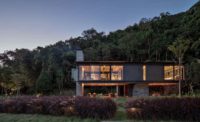Though London's Games have yet to leave the starting block, work on Rio's Olympic venues is well under way.
 |
| Image courtesy AECOM |
| AECOM’s master plan for the waterfront site of the 2016 Olympics in Rio includes several venues adapted from use in previous events, like the 1950 World Cup and the 2007 Pan-American Games. |
The 2012 London Olympics are still a month away, but in Rio de Janeiro, the city is already gearing up for the 2016 Games. In February, the Samb'dromo, home to the city's official samba-school parades, reopened in time for this year's Carnival with the addition of four new grandstands. The parade ground, with its huge concrete parabolic gateway, was designed in 1984 by Oscar Niemeyer, whose office oversaw the new work. (The 104-year-old architect came out to visit the finished site in a golf cart). At the 2016 Games, the expanded Samb'dromo will hold the archery events as well as the start and finish of the marathon.
But the Samb'dromo isn't the only existing venue to be recycled for the 2016 Games. For sports-mad Brazilians, Rio is full of athletic facilities that can be adapted for the Olympics. And like the London Olympics this year, ideas about repurposing existing venues, as well as sustainability and a plan for a post-Games legacy of community improvements, helped Rio win its bid. AECOM, the master planner for the London games, won the commission to design Rio's Olympic Park, on the west side of the city, next to a lagoon, where 15 Olympic events will take place. To avoid the 'white elephant syndrome' in which former Olympic sites are rarely used after the fact, AECOM has a three-phase strategy for the park, says London-based Jason Prior, chief executive of planning, design, and development. The first phase will be the August 2016 Games (and subsequent Paralympic Games), followed by a five-to-seven-year transitional phase. Finally, in the third phase, the Olympic park will be devoted to a mix of uses.
Elsewhere in the city, a number of facilities designed for the 2007 Pan-American Games are being remodeled to Olympic specifications, such as the HSBC Arena and the Maria Lenk Aquatic Park. Rio's famed Maracan' Stadium, which hosted the World Cup in 1950, is currently being renovated for both the 2014 Cup along with the 2016 Olympics. It will host the Opening and Closing Ceremonies and the soccer matches. Track and field events will take place at the Jo'o Havelange Stadium, built in 2007, while the Maracan'zinho Arena, constructed in 1954 but remodeled in 2007, will be the venue for indoor volleyball.
AECOM's plan for the 300-acre Olympic Park, formerly the site of a Formula 1 racetrack, carefully considers what type of sports venues should be constructed on the future legacy site. 'As in London,' says Prior, 'the post-Games development of the site is just as important as the Games themselves.' As a result, some facilities'including a new swimming stadium, a field hockey center, and tennis courts'will be temporary, while others'such as an existing velodrome and several new sports halls'will be kept as an Olympic training center.
Architects for some of the sports facilities will be selected through design competitions sponsored by Rio's city government and the Brazilian Institute of Architects. Meanwhile, the city is spending billions of dollars on new roads and public transportation projects, including rapid-transit bus lanes, to make it easier to get around the city during the World Cup and the Olympics. And, controversially, some of the city's slum dwellers, such as an estimated 4,000 people living at the edge of the park, are being pushed out of their favelas as part of the planning process.
After its experience with the London Olympics, AECOM is now 'better armed' for the job in Rio, says Prior. 'But it's a new country with different ways of doing things.' For now, Prior is looking forward to enjoying the few 2012 Olympic events for which he was able to secure tickets.
Denver writer David Hill is a frequent RECORD contribtuor.





